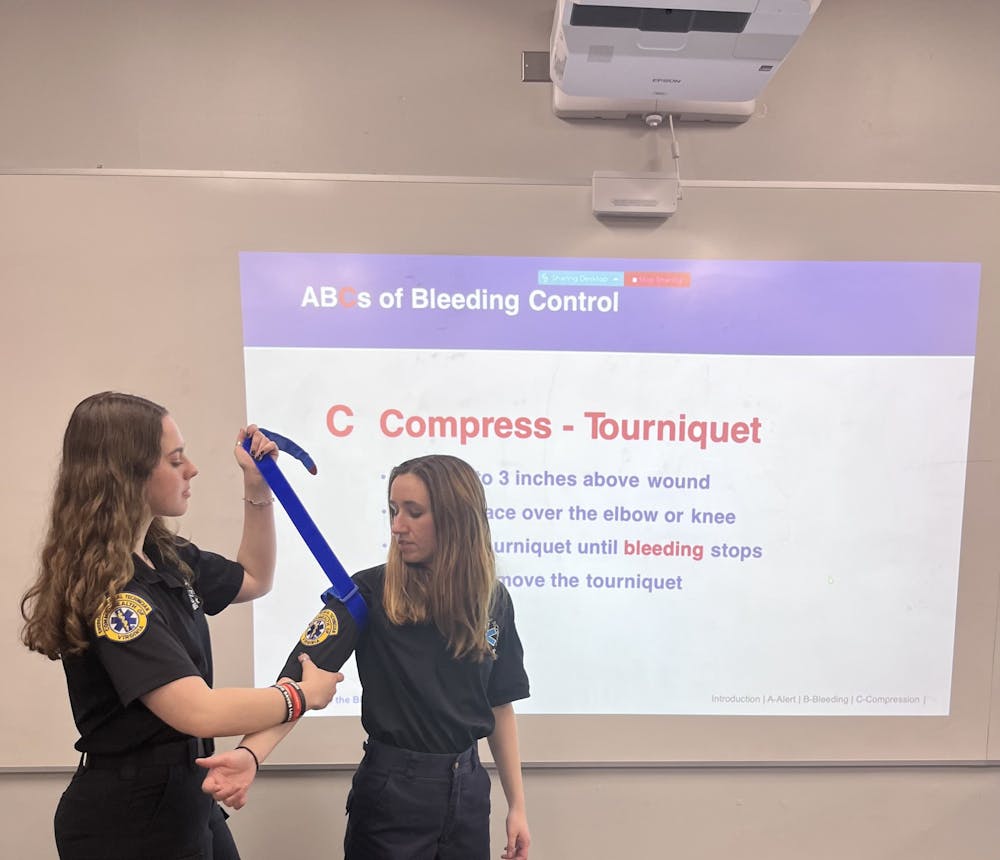The Gottwald Center for the Sciences, University of Richmond Emergency Medical Services conducted their third Stop the Bleed class on Feb. 27.
Participants spent 90 minutes learning how to identify life-threatening bleeds, three ways to treat these injuries and how bystanders can act in situations of serious injury such as shootings and work accidents to save someone’s life.
The training seeks to build injury treatment skills as preventative measures to prepare for such instances rather than waiting to implement them reactively.
“The number one cause of preventable death after injury is bleeding,” senior Lily Bastian, instructor and UREMS Vice President, said at the beginning of the course.
They said that these injuries can result “from within your own home, to on the job to something like what’s all too common today – school shootings.”
UREMS instructors used trainer limbs and partner work to demonstrate the proper way to apply pressure to a wound, efficiently pack a wound and apply a tourniquet to help an injured person. Instructors highlighted essential procedures for using these methods and added their tips based on personal experiences working with injured individuals.
The curriculum comes from the national Stop the Bleed organization, and instructors use questions from participants in previous sessions to enhance their future lessons.
Sophomore and UREMS Membership Officer Elena Zerkin shared that the goal of Stop the Bleed is not to completely replace EMS with bystanders. However, in scenarios of shootings or active threats, EMS is not allowed to enter the scene until the area has been deemed safe, and bystanders may have to administer first aid.
“It could be hours until the adequate personnel enter, so it is really important for individual people to empower themselves and take it upon themselves to learn this stuff,” Zerkin said.
Zerkin brought the nationally recognized Stop the Bleed program to UR after hearing about its implementation at Virginia Tech in response to nationwide shootings and following a shooting near her house which brought the reality of such events close to home, she said. Zerkin and sophomore Holly Wemple, UREMS training officer, now coordinate the program.
The next goal of the Stop the Bleed program is to bring Stop the Bleed kits to campus, Zerkin said. These kits contain the same supplies as those practiced with during the class, but users do not need to have any medical training, and it has been shown that they do not need to have taken the Stop the Bleed class to use them, she said.
“Most people can figure out a tourniquet, they can figure out gauze. What we’re hoping is that in a situation of high stress, at least one person there has taken our training, can fall back into muscle memory and can walk everyone through it,” said Zerkin.
Enjoy what you're reading?
Signup for our newsletter
The UREMS and Stop the Bleed student leadership have discussed the metrics that the program would need to meet before UR invests in these kits with the UR Police Department. While the current goal is to train 1,000 students and faculty, this will prove difficult with a limited number of instructors, Zerkin said.
Bastian suggested possible outreach of the program as a Wellness 101 class or New Spider Orientation, which would allow them to quickly involve as many people as possible and reach that 1,000 students and faculty goal.
Bastian and Zerkin said the program could reach out to “high impact groups” on campus such as resident assistants, tour guides, dining hall facilities, orientation advisors, wellness staff, and people working in high-traffic areas on campus. This training could be repeated every semester and year for new employees, Bastian said.
Outreach is not limited to the UR community. UR Stop the Bleed has been asked by the VCU Emergency Medicine Club to teach some classes to help them begin their own program, said Zerkin.
Since many Greater Richmond community members visit campus for sporting events, Zerkin said that it is also relevant to train people who do not spend every day on campus.
While these kits are still absent from campus, Bastian recommended keeping a personal kit or a few small medical supplies in your backpack.
“Something as small as a piece of gauze can end up saving someone’s life,” Bastian said.
While much of the training centers around helping to stop the bleeding of others, these same strategies can be used to save your own life, Zerkin said.
“I carry a tourniquet in my car. If I was ever in a car accident or if I ever saw a car accident, you can put a tourniquet on yourself. You can wound pack yourself,” Zerkin said. “It's not just about taking care of anyone else around you. It’s like empowering yourself and taking it upon yourself to educate yourself in a way that could one day save your life.”
Most of the promotion for these classes has been done through a Spider Bytes interest form, a network of EMTs on campus and word of mouth, Bastian and Zerkin said. More dates for the classes will be set after spring break based on demonstrated interest.
March 20 through March 24, UREMS will also host Red Week in The Forum to publicize their training opportunities and offer condensed versions of their CPR and Stop the Bleed training sessions. Since many people do not have time to attend the full classes for these programs, UREMS students will teach important skills from each course in about two minutes, Wemple said.
“I think the hardest part is getting people in the door,” Zerkin said. “Once they’re here, they tend to be pretty engaged. We answer any questions they may have, and almost everyone has some form of a question … we love to see that people are thinking about it.”
Contact news writer Katherine Thomey at katherine.thomey@richmond.edu.
Support independent student media
You can make a tax-deductible donation by clicking the button below, which takes you to our secure PayPal account. The page is set up to receive contributions in whatever amount you designate. We look forward to using the money we raise to further our mission of providing honest and accurate information to students, faculty, staff, alumni and others in the general public.
Donate Now


